Swimming pool leaks are a common problem. Artificial ponds for a summer cottage are becoming more and more popular. They have their own advantages, for example, you can not go to the lake, but swim in your backyard at home. Water purity and temperature are also monitored. If a hole appears, there are different materials than to seal the pool so that you no longer face this problem.
The content of the article:
-
Finding the cause and location of leaks
- Hole in the bottom of the pool
- Search on the walls
-
What are artificial reservoirs sealed with?
- waterproof glue
- Repair kit for swimming pools
- Tape or plaster
- Elimination of leakage in the frame pool with a car branch pipe
- What material to choose for patches?
- How to seal a pool filled with water
-
Differences in sealing agents depending on the type of pool
- Child and adult
- Along the seam or just a hole in the wall
- With and without water
- How to prevent the problem from reappearing?
Finding the cause and location of leaks
There are different methods for detecting the location of a pool leak. The simplest is considered the longest. To do this, the pool of water is closed, marking the water level.
- If the next day the amount of liquid inside has decreased, you need to remember and write down what mark it reaches. This must be done until the water stops disappearing.
- If the level remains the same, then it is worth looking for a leak hole at the liquid level around the entire circumference of the pool. If it turned out to be empty, the problem is in the bottom of the structure.
- If the tank has a warranty period, you can call the master, who will fix the hole himself and seal it. If it has expired, then the work will have to be done independently.
Hole in the bottom of the pool
First you need to carefully inspect the valve through which water is drained from the pool. The area that is around is being studied. In the event that the tank valve has not lost its seal, it is necessary to check the bottom around the entire perimeter to find the leak and seal it.
Small debris will help find the hole. It accumulates in small parts in the area of the hole larger than the diameter of the leak. With close inspection, the search will be fast. If the pool is deep, then you need to dive slowly so that the waves do not disperse the accumulation of debris with their vibrations.
If there is no desired result and the hole to be sealed is not found, the water is drained. After that, you need to raise the pool to inspect the area from the outside, where it was. Wet areas of the surface will be a hint of the place where the hole in the bottom is located.
The difficulty in detecting a leak at the bottom of the tank arises from the small amount of water inside. Her pressure is not enough. To remedy the situation, use an electric pump, which is designed for cars or a compressor. Due to the pressure of the air that will come from the unit, bubbles form - they will show the place where the pool leaks.
Search on the walls
There are three ways to find container damage along the walls.
- The first of them, longer, was described above - the search for a hole along the perimeter of the pool, when the water level stopped dropping.
- The second is dry wipes. Running your hand up and down around the entire circumference, you are looking for a place where it will start to get wet more - this is the area that will need to be sealed.
- The third way is the coloring composition. Because of it, the water, coming out, will be colored. Her trace will indicate a hole, which will remain to be sealed with a suitable agent.
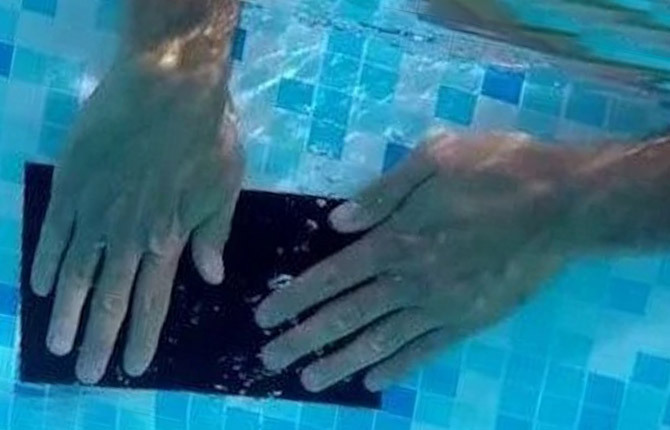
What are artificial reservoirs sealed with?
To seal artificial reservoirs, it is necessary to take only waterproof materials and compounds. To purchase them, you have to go to a hardware or hardware store. Below are five materials and compounds that can be used to seal an artificial reservoir reliably, because they are all time-tested.
waterproof glue
Any waterproof glue that can glue polyvinyl chloride is suitable - often the capacity of an artificial reservoir is made of it. It is sold in a hardware or hardware store everywhere. These include, for example, rubber-based Moment glue. It is suitable for gluing different materials, so it will be the right solution for repairing an artificial reservoir.
Vinyl-based adhesive provides durability and strength to the sealed area. Its advantages are indifference to stretching, compression and other mechanical effects, resistance to high humidity.
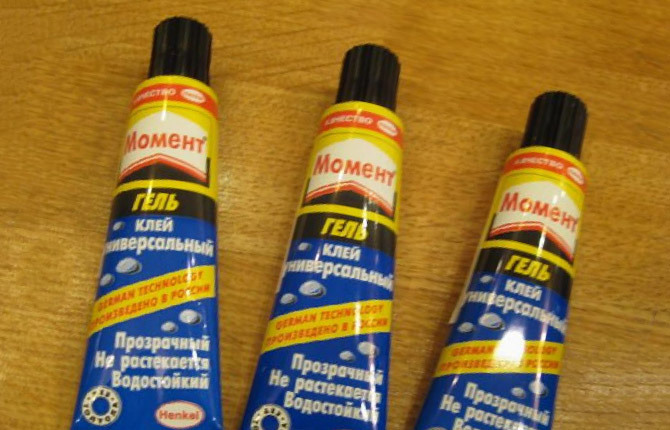
Vinyl glue is great for sealing the hole in inflatable pools. Also, to eliminate the defect, two-component compositions are taken, which are mixed together before work.
Repair kit for swimming pools
Special kits for gluing artificial reservoirs include all the necessary materials. The basic composition is waterproof glue and a few patches made of vinyl. They are sold in the same stores where the pools are, so they are prudently bought together and left in reserve. Using a repair kit as a way to seal the pool is the most durable and reliable, but its price is many times more expensive than others.
The repair kit is easy to use. To quickly seal the pool, you need to cut out a part of the required size under the resulting hole. After that, the composition that comes with the kit is applied to both surfaces. A cut-out patch is placed over the hole, which is pressed against the tank by hand. For reliability, this place should be pressed down with a press so that the hitch is stronger.
Before the full operation of the pool, it is better to check how well it turned out to seal it. Action algorithm:
- wait for the glued area to dry completely;
- pour a small amount of water in this place;
- try to squeeze it out.
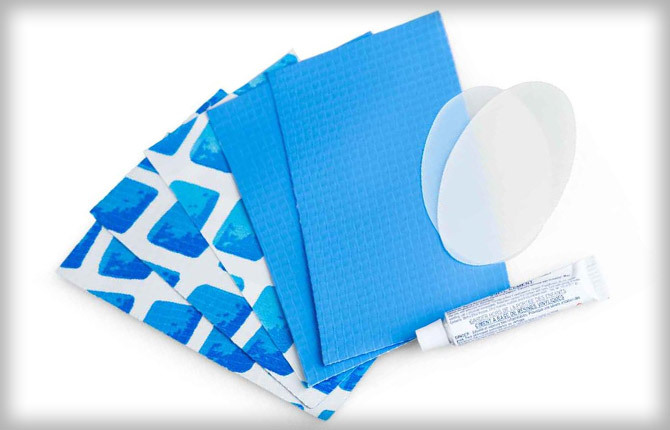
If bubbles or streaks appear, the reservoir is defective and the repair work will have to be repeated. If nothing happens, everything is sealed securely.
Tape or plaster
You can seal the hole in the frame pools with adhesive tape or plaster. Before use, please note that the material must be special, resistant to moisture. The office won't work. How to seal the pool quickly:
- mark the hole;
- carefully remove dust, dirt, etc. in this place of the artificial reservoir;
- degrease with a solution containing alcohol;
- seal the tank with tape.
As an alternative, to seal the tank, you can take a plaster. This type of repair work of frame or inflatable pools is suitable only in urgent situations. For reliable and durable gluing, choose a different material.
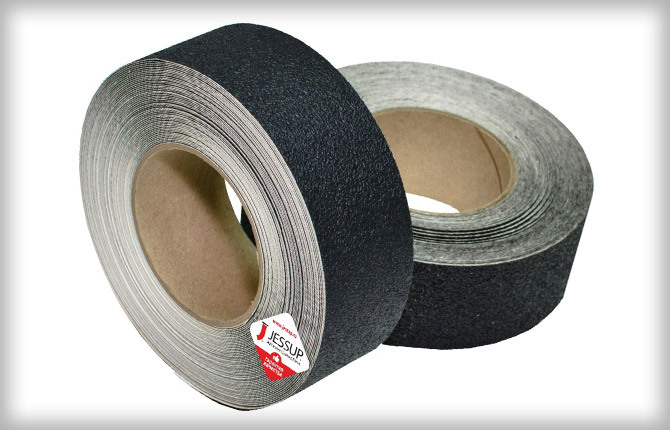
Elimination of leakage in the frame pool with a car branch pipe
When you need to seal a hole in the frame pool, if it is small, you can safely remove the pipe from the car radiator. Styrofoam or fabric (for example, unnecessary old clothes) is placed inside to make it more elastic. What happens next depends on the type of cut.
A puncture on the wall of the tank is eliminated as follows:
- between the two frames closest to the hole, a cord is pulled at the level of the hole;
- an automobile pipe is inserted between the cord and the wall, and the water stops flowing.
If the hole is in the bottom of the pool, then the structure from the machine radiator must be pushed under the edge of the artificial reservoir. Then, with a mount, it must be moved to the area where the leak is located so that the pipe is under it. Do not damage the PVC - insert the pry bar inside the "gluing material".
The water pressure will fix the inserted automobile pipe between the base of the frame tank and its bottom. Such repairs will last at least until the end of the season. An alternative would be a tightly rolled inner tube from a car.
What material to choose for patches?
In order to seal the pool, patches from the manufacturer Intex are suitable. They can eliminate a puncture without draining the water, because these are underwater squares on a self-adhesive basis.
Also, as a material for patches, you can take a moisture-resistant sealant that does not change color. It can withstand ultraviolet rays, applicable to small holes.
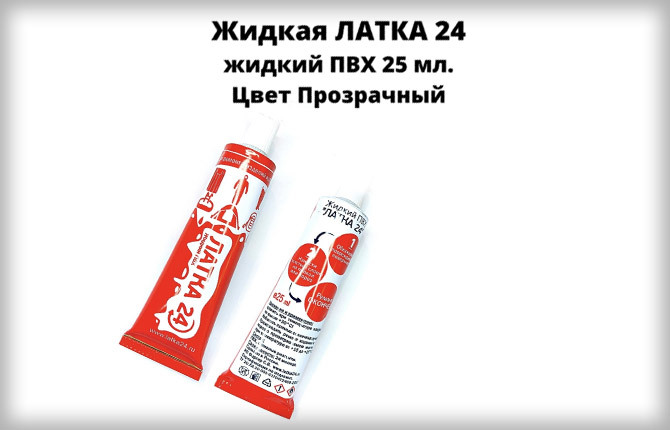
A PVC solution or "liquid patch" is the third tool that seals the holes. Ten minutes is enough for him to grasp with the pool. They seal holes up to three centimeters in diameter.
How to seal a pool filled with water
To seal a filled pool, you will have to choose only materials suitable for this for repair work. The fastest way is to use self-adhesive rubber plates, which can be purchased separately. Repairing a cut in a pool filled with water is a temporary option, a quality fix is only possible without water.
Differences in sealing agents depending on the type of pool
To seal a cut in an artificial reservoir, you need to determine its type. It can be for children or focused on the company of adults. Also, the difference in sealing agents depends on the location of the damage and the location during operation, because not all of the materials are applicable in the house or on the street.
Child and adult
There are three factors that distinguish the models of artificial reservoirs for children. They are made of a thinner material, so the compositions with which adult pools are sealed are not suitable.
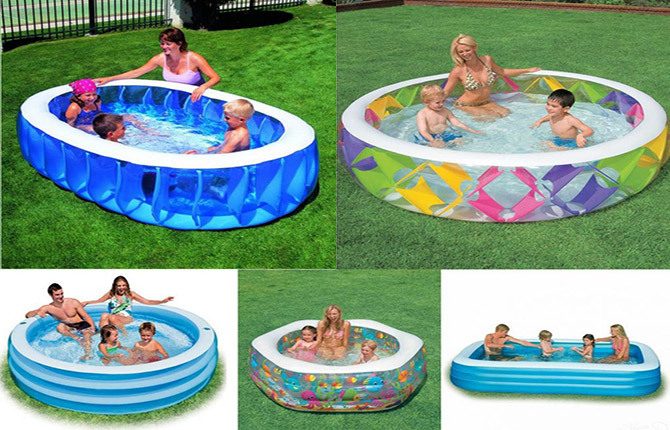
The material should be beautiful and inconspicuous. If the last requirement is not implemented, not only the appearance is lost, but also the attention of children is drawn to the place of damage. Because of this, parents are more likely to opt for kits for repairing a children's pool.
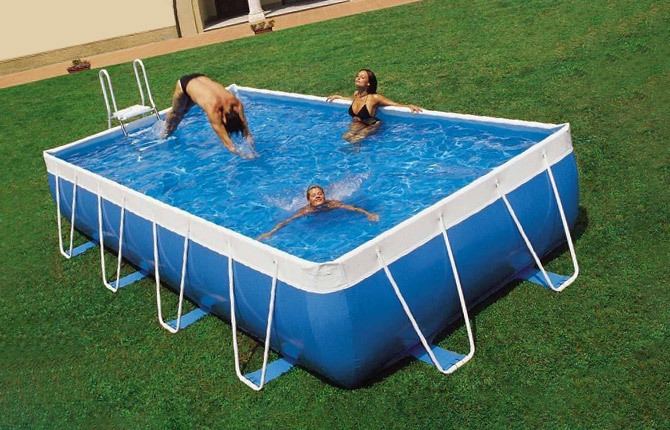
Models for adults, regardless of whether they are frame or inflatable, are made of more durable materials, so different compositions are suitable for gluing. They have other factors and requirements for repair, the main ones are: a flat and clean surface at the puncture or cut site.
Along the seam or just a hole in the wall
If the pool is torn at the seam, the area must first be thoroughly cleaned before sealing. To do this, take soap, water or a special pool cleaner to remove all dirt and grease. Then carefully wipe the seam with a dry cloth so that it is dry, without dust.
When the place is ready for repair, its depth and width are estimated. A density adhesive is purchased that is suitable for this type of pool. Often such formulations are available as a complete set with a coating or separately. It can be of various types, for example soluble in water or solvent. The instructions that are always included will help you figure it out.
Apply glue to the seam, following the algorithm on the package. It is usually required to apply a thin layer of the compound to both surfaces and rub it well with your fingers to ensure a snug fit. Make sure the adhesive is evenly distributed.
After applying the adhesive, wait at least five minutes for it to set, then gently press both sides of the seam together. This position is maintained until completely dry. It is important to allow the adhesive to dry completely before filling the pool with water. The instructions for the adhesive composition indicate the time. When a wall is punctured, the gluing algorithm is similar to repairing a seam.
Pool repairs can be tricky, especially if the person doesn't have the experience or the full set of tools. If you have any doubts or problems with the repair, contact the master.
With and without water
Sealing a pool without water is the more common and recommended approach. When the artificial reservoir is empty, it is easier to reach the problem area, clean it of dirt or dust, apply glue and patch more accurately. It also provides more confidence that the materials are firmly attached to the surface, effectively sealing off leakage.
However, there are cases when it is not always possible to dry the pool, repair it without draining the water. For example, if the seam is at the bottom of the pool and the hole is small. In such cases, sealing the filled tank may be considered.
Sealing a pool of water requires compliance with the technique and approach. It is important to find a way to temporarily stop the flow of fluid from the hole or puncture. For example, you can take a gasket or fixture to temporarily cover a hole while waiting for repairs.
When you need to seal a pool of water, applying glue and patching becomes more difficult. The surface around the hole must be well cleaned and dry before applying the composition. Care must be taken when attaching the patch to avoid additional leaks or damage to the part.
Sealing a pool of water is a temporary solution that may require an early patch or more extensive repair before it is fully usable.
Depending on the circumstances and available resources, it is worth sealing an artificial pond without water, as this will provide a more reliable and lasting repair. If this is not possible, then precautions must be taken to make repairs in full tank, and as soon as possible, drain the water and replace the temporary patch with quality.
How to prevent the problem from reappearing?
To prevent a pool leak from reoccurring, it is important to take the following precautions:
- regular maintenance and inspection;
- maintain the correct water level;
- regular inspection of connections and piping systems;
- proper use and maintenance of equipment;
- use quality materials and professional services;
- regular cleaning and maintenance.
Following these precautions will help minimize the risk of re-opening of artificial ponds and keep it in good condition over a long period of time.
Reading: Which pool is better, Bestway or Intex?
Share in the comments if you had to seal the pool at home. Also repost the article on social media with your friends so they know how to fix the leak and bookmark it. Let's spend the summer in serviceable artificial reservoirs!


